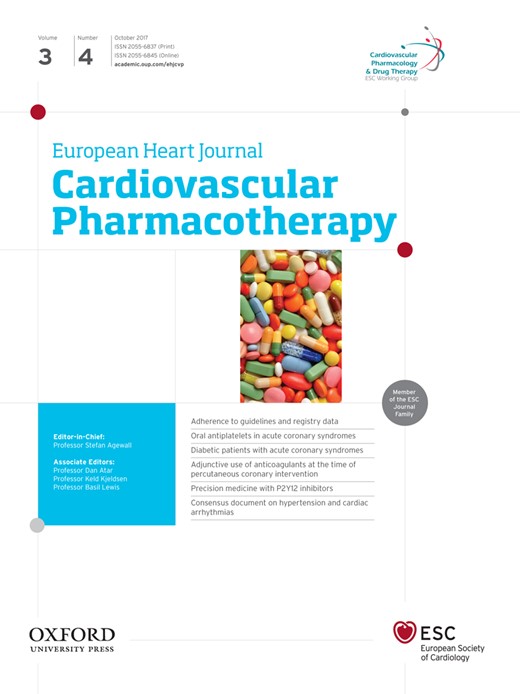-
PDF
- Split View
-
Views
-
Cite
Cite
Stefan Agewall, Adherence to guidelines and registry data, European Heart Journal - Cardiovascular Pharmacotherapy, Volume 3, Issue 4, October 2017, Pages 183–184, https://doi.org/10.1093/ehjcvp/pvx027
Close - Share Icon Share

In this issue of the journal, Dr Claeys and co-workers from Belgium report real-world data in a multicentre study, evaluating the treatment persistence of oral antiplatelet (OAP) therapy during a 1-year follow-up in patients after an acute coronary syndrome (ACS). The proportion of patients still using OAPs after 90, 180, 270, and 360 days was 92, 89, 83, and 73%, respectively. OAP persistence was higher for patients treated with prasugrel or ticagrelor. At 360 days, 79% of patients with an ST-segment elevation myocardial infarction (STEMI) and 66% of patients with a non-STEMI were still adhering to the prescribed course of treatment. The results are important since several previous studies have shown that treatment adherence to guidelines and patient compliance are extremely important issues for the prognosis of patients within cardiology.1–3
In another study with a focus on adherence to international guidelines, Dr Giugliano and co-workers report a retrospective chart review designed to evaluate physician adherence to the prescribing information for fondaparinux regarding adjunctive anticoagulant use during percutaneous coronary intervention (PCI) in patients with an ACS. The study originates from 27 sites across six countries (Canada, France, Germany, Greece, Poland, and Sweden). Over 98% of patients had been treated with fondaparinux at the recommended 2.5 mg dose, and the authors conclude that physician adherence to the prescribing information for adjunctive anticoagulation during PCI in patients with an ACS receiving fondaparinux was high. The results were consistent in each of the six countries and across patient subgroups.
Dr Lettino and Dr Jukema report data from an European registry study.4–6 The authors aimed to provide a descriptive overview of unadjusted analyses of patient characteristics, ACS management, and outcomes up to 1 year after hospital admission for an ACS/index ACS event, in patients with diabetes mellitus in contemporary registries in Europe. A total of 10 registries provided data in a systematic manner on ACS patients with (total n = 28 899) and without diabetes mellitus (total n = 97 505). All-cause mortality in the registries ranged from 1.4% to 9.4% in hospital; 2.8% to 7.9% at 30 days post-discharge; 5.1% to 10.7% at 180 days post-discharge; and 3.3% to 10.5% at 1 year post-discharge. Major bleeding events were reported in up to 3.8% of patients while in hospital (eight registries); up to 1.3% at 30 days (data from two registries only), and 2.0% at 1 year (one registry only). Registries differed substantially in terms of study setting, site, patient selection, definition, and schedule of endpoints, and use of various P2Y12 inhibitors. Pooled risk ratios comparing cohorts with diabetes mellitus vs. no diabetes mellitus were significantly higher in hospital with diabetes mellitus for all-cause death [1.66; 95% confidence interval (CI) 1.42–1.94], for cardiovascular death (2.33; 95% CI 1.78–3.03), and for major bleeding (1.35; 95% CI 1.21–1.52). These registry data from real-life clinical practice confirm a high risk for recurrent events among diabetes mellitus patients with ACS, with great variation across the different registries.
In a multicentre review paper, Dr Siller-Matula and co-workers discuss the role of diagnostic tools such as platelet function and pharmacogenomic testing to personalize antiplatelet therapy. The authors conclude that although the biological underpinnings and observational data supporting personalization are robust, more evidence is needed to recommend personalization as standard of care. This important issue has previously been discussed in the journal.7,8
Finally we publish a Consensus document from the European Heart Rhythm Association (EHRA) and ESC Council on Hypertension, endorsed by the Heart Rhythm Society (HRS), Asia-Pacific Heart Rhythm Society (APHRS), and Sociedad Latinoamericana de Estimulación Cardíaca y Electrofisiología (SOLEACE). Hypertension is a common cardiovascular risk factor leading to heart failure, coronary artery disease, stroke, peripheral artery disease, and chronic renal failure. Hypertensive heart disease can manifest as many types of cardiac arrhythmias, the most common being atrial fibrillation. The authors review the available evidence and publish a joint consensus document on hypertension and cardiac arrhythmias, providing up to date consensus recommendations for use in clinical practice. This consensus document is commented on in an Editorial by Dr Kjeldsen from Norway, Atrial fibrillation and hypertension have also been discussed previously in the journal.9–13
References
Author notes
The opinions expressed in this article are not necessarily those of the Editors of the European Heart Journal or of the European Society of Cardiology.



